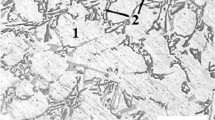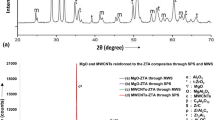Abstract
This investigation reports the effect of thermal shock of different gradients, i.e., immediate transition from high temperature to cryogenic environment and vice versa on the flexural properties of Al2O3 particulate reinforced Cu metal matrix micro- and nano-composites fabricated by powder metallurgy route. The specimens were also thermally conditioned at high as well as sub-zero temperatures separately. The specimens were subjected to 3-point flexural test followed by fractography, and the fracture micro-characteristics were studied under field emission scanning electron microscopy and transmission electron microscopy to predict the dislocation behavior under induced thermal stresses and mismatch. The degree of improvement in flexural strength is higher for the composites experiencing lower degree of thermal shock, i.e., improvement in flexural strength is higher for a thermal shock of 80 °C than for 160 °C temperature gradients. Particle pull-out, crack entrapment, and physical outgripping of alumina particles act as the operative mechanisms during fracture of thermally shocked composites.








Similar content being viewed by others
References
B.C. Ray, Thermal Shock on Interfacial Adhesion of Thermally Conditioned Glass Fiber/Epoxy Composites, Mater. Lett., 2004, 58, p 2175–2177
Z.Y. Ma, J. Bi, Y.X. Lu, and M. Luo, Cryogenic Properties and Fracture Behavior of Discontinuous SiC Reinforced Aluminum Alloy Composites, Scr. Metall. Mater., 1994, 30, p 43–46
P. Poza and J. Llorca, Fracture Toughness and Fracture Mechanisms of Al-Al2O3 Composites at Cryogenic and Elevated Temperatures, Mater. Sci. Eng., A, 1996, 206, p 183–193
B. Inem and G. Pollard, Interface Structure and Fractography of a Magnesium-Alloy, Metal-Matrix Composite Reinforced with SiC Particles, J. Mater. Sci., 1993, 28, p 4427–4434
B.C. Ray, Thermal Shock and Thermal Fatigue on Delamination of Glass-Fiberreinforced Polymeric Composites, J. Reinf. Plast. Compos., 2005, 24, p 713–717
A. Kostka, J. Lelatko, M. Gigla, H. Morawiec, and A. Janas, TEM Study of the Interface in Ceramic-Reinforced Aluminum-Based Composites, Mater. Chem. Phys., 2003, 81, p 323–325
S. Ho and E.J. Lavernia, Thermal Residual Stresses in Metal Matrix Composites: A Review, Appl. Compos. Mater., 1995, 2, p 1–30
S.M. Pickard and B. Derby, The Behaviour of Metal Matrix Composites During Temperature Cycling, Mater. Sci. Eng. A, 1991, 135, p 213–216
J.S. Shelley, R. LeClaire, J. Nichols, Project no: AFRL-PR-ED-TP-2001-023, Air force research laboratory, Edwards AFB, January 2001.
S. Panda, K. Dash, and B.C. Ray, Processing and Properties of Cu Based Micro- and Nano-composites, Bull. Mater. Sci., 2014, 37, p 227–238
K. Dash, S. Panda, and B.C. Ray, Effect of Thermal and Cryogenic Conditioning on Flexural Behavior of Thermally Shocked Cu- Al2O3 Micro- and Nano-composites, Metall. Mater. Trans. A, 2014, 45, p 1567–1578
N. Chawla, C. Andres, L.C. Davis, J.W. Jones, and J.E. Allison, The Interactive Role of Inclusions and SiC Reinforcement on the High Cycle Fatigue Resistance of Particle Reinforced Metal Matrix Composites, Metall. Mater. Trans., 2000, 31A, p 951–957
Z. Zhang and D.L. Chen, Consideration of Orowan Strengthening Effect in Particulate-Reinforced Metal Matrix Nanocomposites: A Model for Predicting Their Yield Strength, Script. Mater., 2006, 54, p 1321–1326
G. Thomas and J. Washburn, Electron Microscopy and Strength of Crystals, Interscience Publishers, New York, 1963, p 131–181
S. Kumar Paul, Predicting the Flow Behavior of Metals Under Different Strain Rate and Temperature Through Phenomenological Modelling, Comput. Mater. Sc., 2012, 65, p 91–99
G.E. Dieter, Mechanical Metallurgy, 2nd ed., McGraw-Hill Book Co., New York, 1976, p 145–183
Acknowledgments
The authors would like to thank the National Institute of Technology (NIT), Rourkela for providing the necessary financial and infrastructural supports.
Author information
Authors and Affiliations
Corresponding author
Rights and permissions
About this article
Cite this article
Dash, K., Ray, B.C. Implications of Degree of Thermal Shocks on Flexural Properties of Cu-Al2O3 Micro- and Nano-composites. J. of Materi Eng and Perform 25, 259–266 (2016). https://doi.org/10.1007/s11665-015-1832-3
Received:
Revised:
Published:
Issue Date:
DOI: https://doi.org/10.1007/s11665-015-1832-3




